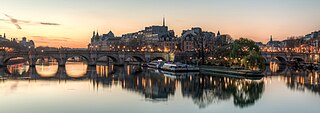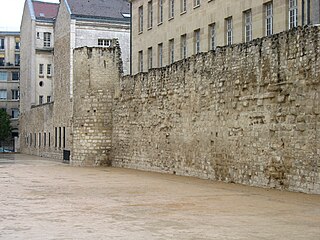
Île de la Cité, 22.5 hectares in size, is one of two natural islands in the Seine, in central Paris. In the 4th century, it was the site of the fortress of the area governor for the Roman Empire. In 508, Clovis I, the first King of the Franks, established his palace on the island. In the 12th century, it became an important religious center, the home of Notre-Dame cathedral, and the royal chapel of Sainte-Chapelle, as well as the city hospital, the Hôtel-Dieu. It is also the site of the city's oldest surviving bridge, the Pont Neuf.

Eugène Freyssinet was a French structural and civil engineer. He was the major pioneer of prestressed concrete.

Île Saint-Louis, eleven hectares in size, is one of two natural islands in the Seine river, in Paris, France. Île Saint-Louis is connected to the rest of Paris by four bridges to both banks of the river and to the Île de la Cité by the Pont Saint-Louis.

The Pont des Arts or Passerelle des Arts is a pedestrian bridge in Paris which crosses the River Seine. It links the Institut de France and the central square of the Palais du Louvre,.

The Pont de Sully is a bridge across the Seine in Paris, France.

The Pont du Carrousel is a bridge in Paris, which spans the River Seine between the Quai des Tuileries and the Quai Voltaire.

The Pont de l'Archevêché is a bridge crossing the Seine river in Paris, France.

The Pont Marie is a bridge which crosses the Seine in Paris, France.
The Pont Notre-Dame is a bridge that crosses the Seine in Paris, France linking the quai de Gesvres on the Rive Droite with the quai de la Corse on the Île de la Cité. The bridge is noted for being the "most ancient" in Paris, in the sense that, while the oldest bridge in Paris that is in its original state is undoubtedly the Pont Neuf, a bridge in some form has existed at the site of the Pont Notre-Dame since antiquity; nonetheless, it has been destroyed and reconstructed numerous times, a fact referred to in the Latin inscription on it to honor its Italian architect, Fra Giovanni Giocondo. The bridge once was lined with approximately sixty houses, the weight of which caused a collapse in 1499.

The Petit Pont is an arch bridge crossing the River Seine in Paris, built in 1853, although a structure has crossed the river at this point since antiquity. The present bridge is a single stone arch linking the 4th arrondissement and the Île de la Cité, with the 5th arrondissement, between quai de Montebello and quai Saint-Michel. The Petit Pont is notable for having been destroyed at least thirteen times since its original inception during Gallo-Roman times to the mid-19th century.

The Pont Louis-Philippe is a bridge across the River Seine in Paris. It is located in the 4th arrondissement, and it links the Quai de Bourbon on the Île Saint-Louis with the Saint-Gervais neighborhood on the right bank.

The pont de Tolbiac is a bridge across the Seine in Paris built between 1879 and 1882 by H.P. Bernard, and J.D.A. Pérouse. It crosses from the 12th to the 13th arrondissement, linking quai de Bercy to rue Neuve Tolbiac. Its nearest Paris Metro station is Cour Saint-Émilion.

The Bassin de la Villette is the largest artificial lake in Paris. It was filled with water on 2 December 1808. Located in the 19th arrondissement of the capital, it links the Canal de l'Ourcq to the Canal Saint-Martin, and it represents one of the elements of the Réseau des Canaux Parisiens, a public-works authority operated by the city. The other components of the network are the Canal de l'Ourcq, the Canal Saint-Denis, the Canal Saint-Martin, and the Bassin de l'Arsenal. Together, these canals and basins extend roughly 130 kilometres (81 mi).

The city walls of Paris refers to the city walls that surrounded Paris, as it grew from ancient times until the 20th century, built primarily to defend the city but also for administrative reasons. Several successive city walls were built over the centuries, either adding to existing walls or replacing demolished ones, through 1846, when construction of the Thiers wall was completed.

The Wall of Philip Augustus is the oldest city wall of Paris (France) whose plan is accurately known. Partially integrated into buildings, more traces of it remain than of the later fortifications.

The Château de la Tournelle was a now-demolished castle on the left bank of the Seine in the 5th arrondissement of Paris on the quai de la Tournelle. The approximate site is now occupied by the restaurant La Tour d'Argent. After it were named the pont de la Tournelle and the quai de la Tournelle.
In French, a Tournelle may refer to :

The Zouave is an 1856 stone statue by French artist Georges Diebolt, which has been sited on the Pont de l'Alma in Paris since the 1850s. The statue is used as an informal flood marker for the level of the River Seine in Paris.



















